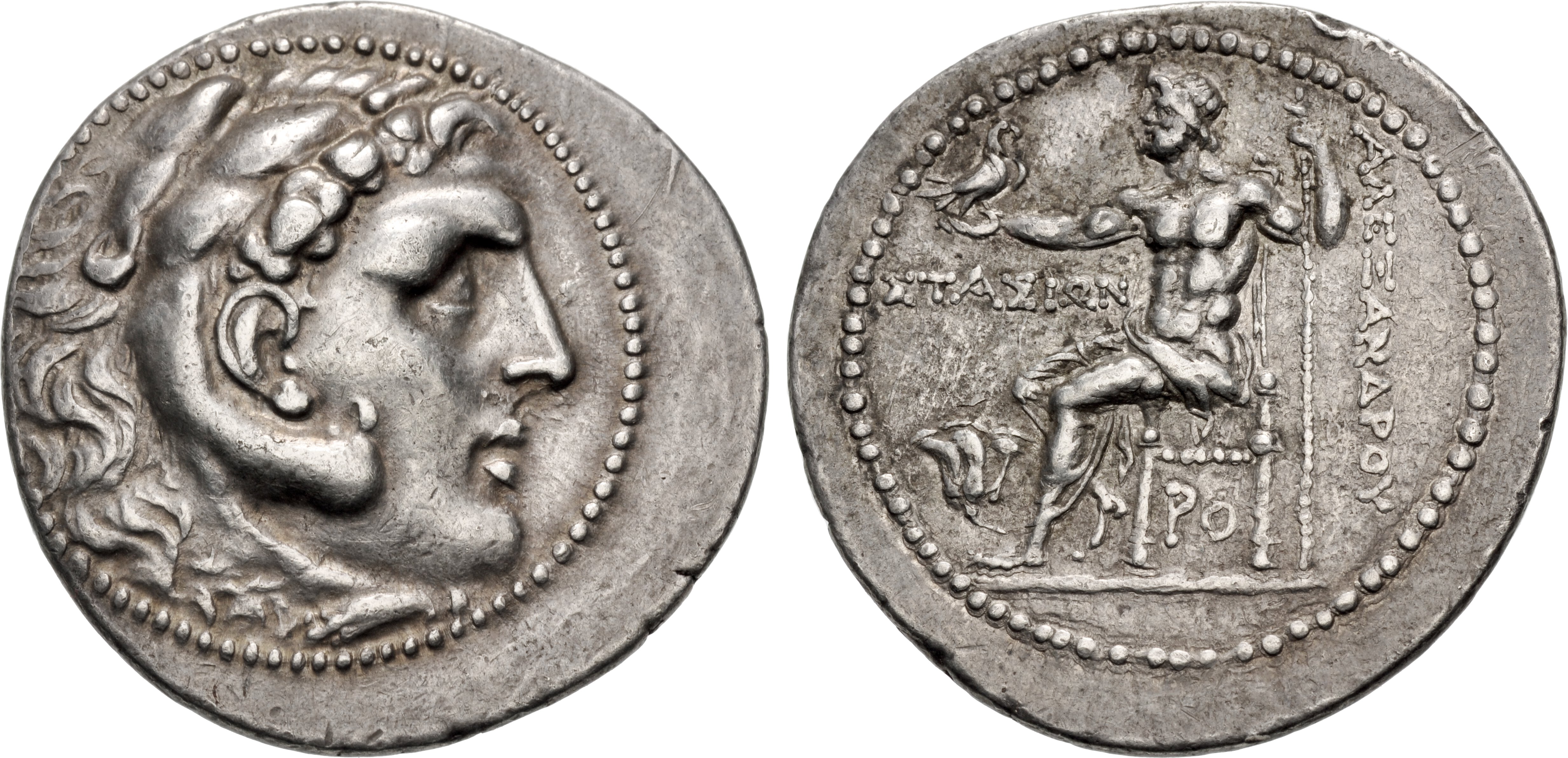Rhodes (Alexander the Great), silver, tetradrachms (Heracles/Zeus) (202-188 BCE)
From SILVER
202 BCE - 188 BCE Silver 14,015 kg
Description
| ObverseInscription or printing placed on the obverse.: | Head of Heracles right, wearing Nemean lion skin headdress. Border of dots. |
| ReverseInscription or printing placed on the reverse.: | AΛΕΞΑΝΔΡΟΥ - ΣΤΑΣΙΩΝ (Greek).Zeus Aëtophoros seated left, in left field, rose in l. field, PO below throne |
Mint and issuing power
| MintIdentifies the place of manufacture or issue of a numismatic object.: | Rhodes | Ancient regionAncient region.: | Caria (islands) | Modern countryModern country: Greece | AuthorityIdentifies the issuing power. The authority can be "pretended" when the name or the portrait of X is on the coin but he/she was not the issuing power. It can also be "uncertain" when there is no mention of X on the coin but he/she was the issuing power according to the historical sources: | Alexander III the Great (Argead king, 336-323 BC) |
Chronology
| FromIdentifies the initial date in a range assigned in a numismatic context. | 202 BCE | toIdentifies the final date in a range assigned in a numismatic context.. | 188 BCE | PeriodTime period of the numismatic object.: Hellenistic 323-30 BC |
Physical description
| MetalThe physical material (usually metal) from which an object is made.: | Silver |
Median weightMedian of the weights of numismatic objects (in grams). in grams | 17.00 | DenominationTerm indicating the value of a numismatic object. Examples: tetradrachm, chalkous, denarius.: | tetradrachm |
StandardStandard.: | Attic |
Image

H246 Rhodes alexanders.jpg [1]
References
| Die study referencePublication of the study: | Kleiner 19711Kleiner 1971 | ||
| Coin series referenceReference to coin series study: | Price 19912Price 1991, n° 2509-2527, RQEMH3RQEMH, n° 246 | ||
| Coin series web referenceCoin series web references: | |||
Obverse dies distribution
| FrequencyFrequency of specimen in distribution. ᵖ | Number of obversesNumber of obverse dies. ᵖ (o) | % (o) | Number of coinsNumber of coins. (n) | % (n) | Die nameName(s) of the die(s). |
| 1 | 16 | 43.24 | 16 | 8.79 | D, F, G, H, K, P, V, W, AA, BB, EE, FF, GG, HH, JJ, KK |
| 2 | 4 | 10.81 | 8 | 4.4 | J, O, Y, II |
| 3 | 2 | 5.41 | 6 | 3.3 | C, E |
| 4 | 1 | 2.7 | 4 | 2.2 | I |
| 5 | 2 | 5.41 | 10 | 5.49 | S, N |
| 6 | 2 | 5.41 | 12 | 6.59 | A, CC |
| 7 | 3 | 8.11 | 21 | 11.54 | B, L, M |
| 8 | 2 | 5.41 | 16 | 8.79 | U, DD |
| 9 | 1 | 2.7 | 9 | 4.95 | Q |
| 10 | 1 | 2.7 | 10 | 5.49 | R |
| 16 | 1 | 2.7 | 16 | 8.79 | Z |
| 22 | 1 | 2.7 | 22 | 12.09 | T |
| 32 | 1 | 2.7 | 32 | 17.58 | X |
| Total | 37 of 37 | 100 | 182 of 182 | 100 |
Reverse dies distribution
no distribution is available
Quantification
| Number of obversesNumber of obverse dies. ᵖ (o) | 37 | Number of singletons (o1)The number of singleton coins. ᵖ | 16 |
| Number of reverse diesNumber of reverse dies. (r) | 142 | Number of coinsNumber of coins. (n) | 182 |
| Coins per obverse dieNumber of coins per obverse die. (n/o) | 4.92 | Coins per reverse dieNumber of coins per reverse die. (n/r) | 1.28 |
| Reverse per obverse ratioRatio of obverse dies divided by reverse dies. (r/o) | 3.84 | Percentage of singletons (o1)number of coins (n) divided by the number of singletons (o1) ᵖ | 43.24 % |
| Original number of dies (O) (Carter 1983 formula)The estimation of the number of coins according to Carter 1983 ᵖ | 41.22 | Coins struck if 20,000 as average productivity per dieCoins made if the average productivity for obverses (according to Carter) is 20,000. ᵖ | 824,400 |
| Original number of dies (O) (Esty 2011 formula)The estimation of the number of coins according to the singleton formula in Esty 2011 ᵖ (O) | 46.44 | Survival rate if 20,000 as average productivity per dieSurvival rate if average productivity is 20,000. ᵖ | 0.00022 |
| Coverage (o = % of O) (Esty 1984 formula)Esty 1984 - coverage (% of O) ᵖ (o = % of O) | 91.21% | Die productivity if survival rate 1/2,000Average productivity if survival rate is 1/2,000. ᵖ | 8,830.66 |
| Weight of silver (in kg) if 20,000 coins per die (O = Carter formula)Carter 1983 * Median weight * 20000 (*10 if gold or electrum) ᵖ | 14,015 kg <br /> 14,015 kg | Die productivity if survival rate 1/5,000Average productivity if survival rate is 1/5,000. ᵖ | 22,076.66 |
Remarks
References
- ^ Kleiner, Fred S. (1971), "The Alexander Tetradrachms of Pergamum and Rhodes", American Numismatic Society. Museum Notes, 17, p. 95-125, pl. 21-34.
- ^ Price, Martin Jessop (1991), The Coinage in the Name of Alexander the Great and Philip Arrhidaeus: a British Museum Catalogue, 2 vol., Zürich-London, 637 p., 637 p., clix pl.
- ^ Callataÿ, François de (1997), Recueil quantitatif des émissions monétaires hellénistiques, Numismatique Romaine, Wetteren, X + 341 p.